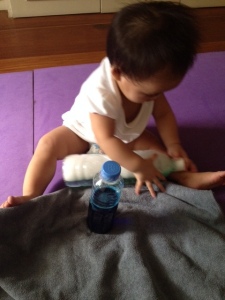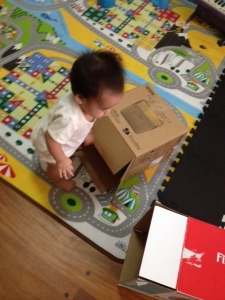I think any parent will agree with me that there is something about toy stores that draw us towards entering them. There’s this small voice within us that tries to convince us, “I might find something, maybe just a small item that my baby will like.” No wonder, my husband, Mike will ask beforehand if I can just give him a call when I’m done at the toy store. He knows very well that next to the bookstore and the grocery, this is another place where I really take my time. 🙂
What is really necessary for babies? This is a question that I’m so sure that every parent asks themselves. This is because we are always concerned with the hows, the whys, and the whats of babies’ toys. Of course, every parent would always want the best for his child. But the bigger question is, in our desire to giving the best, are we really choosing the right one for our child? What are our considerations in choosing our child’s toys?
Magda Gerber explains that rather than calling these objects as “toys”, she prefers to call them as “play objects”. According to her, “we say that a baby is playing when she is manipulating an object (even if it is her own hand), so in fact, any object a baby would choose to manipulate would be a play object“. (p. 97)
Here are important considerations that you should keep in mind when choosing your baby’s play objects:
1. Developmentally Appropriate: Choose play things that suit your child’s developmental level and age. Toys that suit your child’s developmental needs will build his self-esteem as it nurtures that “I can do it” feeling. In the same way, if it’s developmentally appropriate then it will help build on other important skills such as, fine and gross motor skills (big and small muscles), ability to communicate, ability to understand cause and effect, and social skills, too.
Gerber explains that play objects for babies should be simple, cleanable and sturdy. This means that there should be a variety of shape, sizes and weights available for the child to explore (but not too heavy which may cause any form of injury). The way these materials are arranged together with its furnishings should be child-friendly in terms of size, location and space. (How to design your child’s physical environment is another topic that I will discuss in my future posts).
Keep in mind that play objects for your infants should be those that your baby can touch, look at, hold, mouth, grasp and manipulate. You can easily find them in your own homes. There is no need to purchase them at all.
For Gerber, the top 5 play objects for babies are the following (which you need to also have at home):
1. Scarf: This is about 18 inches square made of sturdy cotton or linen (Don’t use silk, nylon or any flimsy). You can sew different colours or patterns together. You can hold the scarf in the middle and let it stand to form a peak. Place it in such a way that the baby can reach for it, touch it and hold it. You will be surprised at how many ways and how long your baby will explore the scarf.
2. Containers: These are plastic and light weight containers such as cups, bowls, colanders, dishpans, baskets in varied sizes, shapes and colours. It allows the child to explore the concepts of “in” and “out” while he is able to take control of both the object and the activity. Infants will often use them to make sounds as they tap it against each other, or on the floor. You can also include molded ice cube trays and lightweight, shiny metal plates/pans.
3. Balls: Balls that are big and small and most especially, those with holes (as infants will enjoy inserting their fingers through the holes as they move about). Beach balls of varying firmness and rubber balls (just make sure the material is safe for babies).
4. Bottles, Chains/Links: Empty plastic bottles of varying sizes are of interest to babies. Make sure that they are cleaned thoroughly and no rough/sharp edges. You can add variety by placing items inside that can make noise, or produce colour (bubble bath soap, food colouring). make sure that the bottles are sealed properly. Plastic Chains/Links are also interesting for babies to manipulate. Make sure that these are flexible and not long enough to tangle around the infants’ body parts.
5. Boxes: These boxes can be crawled in, through or on and the smaller boxes can serve as containers for other materials. With boxes, you can create tunnels, pretend vehicles and walls to add fun to your child’s play time. Make sure that the boxes are safe, sturdy with no sharp/rough edges.
What do these play objects have in common?
Surprisingly, these play things will not do anything unless an infant activates them. Gerber further explains that, “our active infant manipulates passive objects“. None of these materials are battery-operated or electronic in nature that cause a passive baby to just watch an active play object. Wherein it enables a child to expect to be entertained rather than to create opportunities for exploration.
I also included other play materials categorized according to an infant’s age and developmental level based on other sources: (Center for and Family Studies, Far West Laboratory for Educational Research and Development)
1. Young Infants: Birth-3 months: Things to look at and listen to, such as family activities, pets, housework, music, plants, pictures, mirrors and music boxes
2. Young Infants: 2-6 months: Things to squeeze, pat, grasp, place in mouth and touch, such as soft toys, tethers, rattles, empty spools, empty food cartons, scarves, plastic rings, rubber soap pads, big pop beads
3. Mobile Infants: 3 months-8 months:
a) Things to kick, swipe, bat, bang, rub and shake that cause something to happen such as: squeak toys, plastic keys on a ring, plastic balls with sound or movement inside.
b) objects to combine with other objects-to pile, clap together, put in and take out, pull, push and scoop such as baskets and buckets, stacking cups and boxes, balls, stacking rings, busy boxes, pegs and holes, nesting bowls.
c) things to explore through touch such as: natural objects (non-toxic plants, water, leaves, shells), mesh vegetable bags, sheer curtains, foil, paper bags, sensory boxes, new sponges
d) things to explore through sight: photos, drawings, cloth and cardboard picture books, plastic bottles or cans with colourful objects inside.
e) objects that can encourage movement: balls (small and large), small wheel toys, tunnels, ramps
f) things that respond dramatically to manipulation such as bells, busy boards, pot and wooden spoon, scarves and cloths that float and wave
g) real and play things similar to those used by adults such as plastic or wooden kitchen utensils, telephones, dolls, toy animals, blankets, cribs, cupboards
4. Older Infants: 8 months-12 months:
a) Objects for sorting and building, putting together and taking apart such as puzzles, large and small blocks, hook-together trains, threading toys, sorting cards, pegboards.
b) objects that can be used in art such as water colours, food colouring, construction paper, non-toxic art materials
c) musical instruments
d) story activities such as story books, magazines, felt boards and puppets.
d) objects that expand dramatic play such as telephones, dishes, dolls, shopping carts, dress-up clothes, blankets, doll cribs, hats, non-breakable mirrors, watering cans.
e) objects that encourage large movements and physical play such as empty cartons, big boxes, balls. push and pull toys.
2. Safety: Judy Herr identified three questions to ask before choosing a toy for your child:
a) can the toy be swallowed?
b) are there small parts that could be placed in the ears or mouth?
c) Is the toy easy to clean?
d) Are there sharp points or edges on the toy?
Avoid play materials that may cause suffocation, those with liquid inside, made of heavy wood, and long strings attached. Always be careful when giving any material to your child as they are at the stage that they want to put everything and anything into their mouths.
The U.S. Consumer Product Safety Commission specified that for children under the age of 3, small parts on toys must be at least 1 1/4 inches in diameter or 2 1/4 inches long. Any parts smaller than these are already potential choking hazards. A rule of thumb that you can easily use to test a acceptable size is using the core of the toilet paper roll: if the toy falls through the hole, then it should be kept away.
3. Purpose and Goal: Find out if that particular play object will help develop creativity/imagination, involve your child in its use, learn specific skills. Choose play materials that are open-ended because this will help your child to express his creativity. Materials such as blocks, water, can be used by children to find infinite ways to manipulate them. Think about specific skills that this play object can target for your child such as large muscle development, eye-hand coordination, social skills.
In summary, here are guide questions that you need to keep in mind when choosing a play material for your child whether you are at a toy store, a thrift store (ukay-ukay) or at your home.
1. Is it appropriate for the developmental stage of my child?
2. Is it safe?
3. Is it durable? Is it easy to maintain?
4. does it require the involvement of my child?
5. Is it of interest to my child?
Parents, keep in mind that, “the best play objects are those which allow infants to be as active and competent as possible at every stage of development“. (Gerber, 1998).
References:
Gerber, M. (1998). Dear Parent, Caring for Infants with Respect. Los Angeles, California: Resouces for Infant Educarers.
Herr, J. (1998). Working with Young Children. Illinois: The Goodheart-Willcox Company.
Center for and Family Studies and Far West Laboratory for Educational Research and Development (1990). Play Material for Young Infants, Mobile Infants, and Older Infants. Program for Infant-Toddler caregivers. Sacramento, CA: California Department of Education






Comments are closed here.